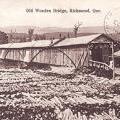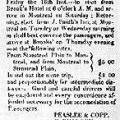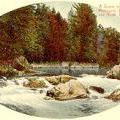Transportation
The Railway Boom
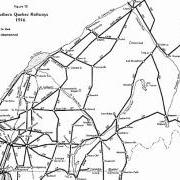 The 19th century saw a massive railway boom all across the Eastern Townships. Driven by the need to access raw materials, the desire for rapid transit, and a mania to build more and more branch lines, companies vied for territory and markets. By 1900, a network of local and regional railway lines crisscrossed virtually every corner of the region.
The 19th century saw a massive railway boom all across the Eastern Townships. Driven by the need to access raw materials, the desire for rapid transit, and a mania to build more and more branch lines, companies vied for territory and markets. By 1900, a network of local and regional railway lines crisscrossed virtually every corner of the region.
Boom des voies ferrées
 Le 19e siècle a connu un important boom des voies ferrées partout dans les Cantons-de-l'Est. Poussées par la nécessité d'accéder aux matières premières, par le désir d'un transit rapide et par la frénésie de construire de plus en plus d'embranchements, les compagnies se disputaient le territoire et les marchés.
Le 19e siècle a connu un important boom des voies ferrées partout dans les Cantons-de-l'Est. Poussées par la nécessité d'accéder aux matières premières, par le désir d'un transit rapide et par la frénésie de construire de plus en plus d'embranchements, les compagnies se disputaient le territoire et les marchés.
Diligences
Copp's Ferry
Copp's Ferry
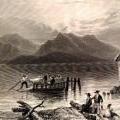 The first commercial ferry on Lake Memphremagog, and certainly one of the first in the Eastern Townships, was Moses Copp's ferry, in the aptly-named village of Copp's Ferry (later Georgeville). About 1797, shortly after his arrival in the area, Copp built a scow, which operated by manpower (oars) between the east and west sides of the lake.
The first commercial ferry on Lake Memphremagog, and certainly one of the first in the Eastern Townships, was Moses Copp's ferry, in the aptly-named village of Copp's Ferry (later Georgeville). About 1797, shortly after his arrival in the area, Copp built a scow, which operated by manpower (oars) between the east and west sides of the lake.
Premières routes
The First Roads
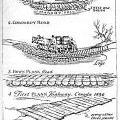 The first settlers found no roads. They came to a land of virgin forest. They had to blaze their own trails, and find their way around swamps and over streams. They travelled in winter from New England, because snowshoes and a laden sled required a narrower path than an ox cart, and because they could save time by travelling over frozen lakes and rivers.
The first settlers found no roads. They came to a land of virgin forest. They had to blaze their own trails, and find their way around swamps and over streams. They travelled in winter from New England, because snowshoes and a laden sled required a narrower path than an ox cart, and because they could save time by travelling over frozen lakes and rivers.
Premiers voyages sur lacs et rivières
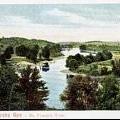 Avant que la région ne soit ouverte à la colonisation, les voyageurs devaient s'astreindre à utiliser les principaux lacs et cours d'eau des Cantons-de-l'Est pour se rendre dans cette région. Figurant en tête de liste des grandes étendues d'eau de la région, les lacs Champlain et Memphrémagog chevauchaient tous deux la frontière canado-américaine.
Avant que la région ne soit ouverte à la colonisation, les voyageurs devaient s'astreindre à utiliser les principaux lacs et cours d'eau des Cantons-de-l'Est pour se rendre dans cette région. Figurant en tête de liste des grandes étendues d'eau de la région, les lacs Champlain et Memphrémagog chevauchaient tous deux la frontière canado-américaine.
Routes des Abénaquis dans les Cantons-de-l'Est
Pagination
- Page précédente
- Page 4
- Page suivante
